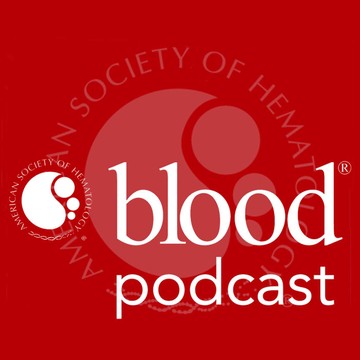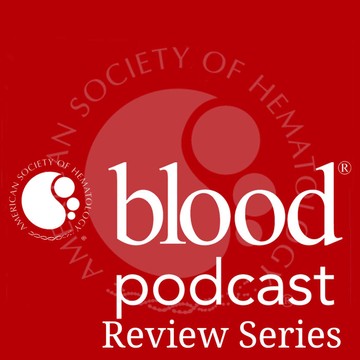

Blood Podcast
American Society of Hematology
The Blood Podcast summarizes content recently published in Blood, the most cited peer-reviewed publication in the field of hematology.
Episodes
Mentioned books

Dec 18, 2025 • 20min
Novel Differentiation Therapies for AML and Prognostic Value of PET in MM
Vijay Sankaran, a physician-scientist in hematology research, Ruud Delwel, a leukemia biology expert, and Françoise Kraeber-Bodere, a nuclear medicine physician, delve into groundbreaking studies on the MECOM gene's impact on acute myeloid leukemia therapies. They explore how MECOM repression might enhance CEBPA expression to promote differentiation in leukemias. Also discussed are the promising results from the CASSIOPET study showing that pre-maintenance PET negativity is a strong prognostic indicator for multiple myeloma outcomes.

Dec 11, 2025 • 19min
Review Series on Platelet Heterogeneity
In this Review Series episode, Blood Associate Editor, Dr. Elisabeth Battinelli discusses the Platelet Heterogeneity with authors Drs. Craig Morrell, Larry Frelinger, and Leo Nicolai. Find the full review series in volume 146 issue 24 of Blood.

Dec 5, 2025 • 21min
Special Episode: Maternal Health in Hematology
In this special episode, Blood editor Dr. Laura Michaelis interviews Dr. Arielle Langer and Blood Associate editor Dr. Marc Blondon for this special Maternal Health episode. In honor of the second Maternal Health compendium, both discuss their papers featured in this special collection. Featured Articles: β-Thalassemia minor is associated with high rates of worsening anemia in pregnancyLongitudinal profile of estrogen-related thrombotic biomarkers after cessation of combined hormonal contraceptivesSee the entire Maternal Health Compendium Second Edition

Dec 4, 2025 • 16min
Analysis of IELSG37 Trial Results and PF4 in Stem Cell Aging
In this discussion, Emanuele Zucca, an oncologist and lymphoma expert, delves into the IELSG37 trial, revealing that the standard R-CHOP21 regimen for primary mediastinal B-cell lymphoma may be less effective than hoped. Sen Zhang, a researcher in pharmacology, explores platelet factor 4's critical role in stem cell aging, highlighting how PF4 deficiency accelerates aging traits in stem cells. Both experts emphasize translational implications for improving therapies and rejuvenating aged hematopoietic stem cells, sparking new hope in regenerative medicine.

Nov 27, 2025 • 22min
Fixed-Duration Epcoritamab Combination Therapy for Relapsed or Refractory Follicular Lymphoma and Pre-Transplant Strategies for GVHD post-HSCT
In this week's episode, Blood editor Dr. Laurie Sehn interviews authors Drs. Lorenzo Falchi and Robert Levy on their latest papers published in Blood Journal. Dr. Falchi discusses his work on an open-label, multicenter phase 1b/2 study evaluating fixed-duration epcoritamab with rituximab and lenalidomide in 108 patients with relapsed or refractory follicular lymphoma. Dr. Levy shares his work on demonstrating that in vivo expansion of Tregs in recipients prior to transplant is possible by activating TNFRSF25 (also known as death receptor 3) in combination with low-dose interleukin-2 in preclinical models. Both papers showed impressive and promising results for the treatment of lymphoma and GVHD.Featured ArticlesFixed-Duration Epcoritamab Plus R2 Drives Favorable Outcomes in Relapsed or Refractory Follicular LymphomaPre-transplant targeting of TNFRSF25 and CD25 stimulates recipient Tregs in target tissues ameliorating GVHD post-HSCT

Nov 20, 2025 • 15min
Advancing Blood Disorder Treatments Through Precision Therapeutics
Terri Parker is a hematologist and clinical researcher focusing on AL amyloidosis, while Peter Lenting specializes in bleeding disorders. They discuss groundbreaking advancements in treatments for these conditions. Parker reveals impressive results from a phase 2 trial using isatuximab in AL amyloidosis, showcasing a 77% hematologic response. Meanwhile, Lenting shares his innovative work on a bispecific nanobody designed to extend the half-life of von Willebrand factor, potentially transforming care for patients with type 1 VWD.

Nov 13, 2025 • 19min
New Research: Mitochondrial DNA in TRALI and Venetoclax-Obinituzumab in CLL Trials
Join Dr. John Semple, a researcher at Lund University specializing in transfusion-related lung injuries, as he discusses how mitochondrial DNA acts as a critical trigger for TRALI via TLR9 signaling. Dr. Othman Al-Sawaf studies chronic lymphocytic leukemia and reveals surprising insights about patient fitness, highlighting that both fit and unfit patients respond similarly to treatment with venetoclax and obinutuzumab. Their research challenges existing views and suggests new pathways for understanding and treating these conditions.

9 snips
Nov 6, 2025 • 10min
Bispecific Antibodies in Aggressive B-Cell Lymphoma: Real-World Insights and Future Directions
In this insightful conversation, Dr. Taylor Brooks, a clinician and researcher from the Cleveland Clinic, sheds light on bispecific antibodies like epcoritamab and glofitamab in treating aggressive B-cell lymphoma. He discusses their innovative mechanisms and how they address a critical need for patients with relapsed or refractory diffuse large B-cell lymphoma. Key findings from his study reveal promising response rates and survival outcomes, while also highlighting the necessity for further research on TP53 mutations and future treatment strategies.

22 snips
Oct 30, 2025 • 18min
Review Series on Follicular Lymphoma
Join Dr. Sarah C. Rutherford, a lymphoma specialist, Dr. Carla Casulo, a clinician-scientist tackling relapsed follicular lymphoma, and Dr. Aaron Perry, a researcher focused on lymphoma biology. They delve into innovative treatment strategies like bispecific antibodies and CAR T-cell therapies. The conversation explores personalizing therapies based on patient history, the biology behind lymphoma transformation, and how emerging tools like ctDNA can guide treatment choices. Plus, they discuss the potential for cures and the complexities of managing high-risk cases.

Oct 23, 2025 • 24min
Breakthroughs in Multiple Myeloma Treatment and Von Willebrand Disease Mechanisms
In this week's episode of the Blood Podcast, Associate Editor Dr. James Griffin interviews Drs. Binod Dhakal and Ruben Bierings about their respective papers published in this week's issue of Blood. Dr. Dhakal presents his study on using talquetamab, a bispecific antibody, as a bridging therapy before BCMA-targeted CAR T-cell therapy in multiple myeloma patients, showing promising results with high response rates and manageable toxicities. Next, Dr. Bierings identified patients with genetic variants in the guanine exchange factor MAP kinase–activating death domain (MADD) that impair VWF secretion from endothelial cells and possibly cause VWD type 1. Featured ArticlesA novel cause of type 1 von Willebrand disease: impaired exocytosis of Weibel-Palade bodies due to biallelic MADD variantsSophie Hordijk, Stijn A. Groten, Petra E. Bürgisser, Sebastiaan N. J. Laan, Georg Christoph Korenke, Tomáš Honzík, Diane Beysen, Frank W. G. Leebeek, Paul A. Skehel, Maartje van den Biggelaar, Tom Carter, Ruben BieringsSequential targeting in multiple myeloma: talquetamab, a GPRC5D bispecific antibody, as a bridge to BCMA CAR-T therapyBinod Dhakal, Othman S. Akhtar, David Fandrei, Alexandria Jensen, Rahul Banerjee, Darren Pan, Shambavi Richard, Reed Friend, Matthew Rees, Patrick Costello, Mariola Vazquez Martinez, Oren Pasvolsky, Charlotte Wagner, James A. Davis, Omar Castaneda Puglianini, Ran Reshef, Aimaz Afrough, Danai Dima, Manisha Bhutani, Omar Nadeem, Ricardo Parrondo, Ciara Freeman, Lekha Mikkilineni, Shahzad Raza, Larry D. Anderson Jr, Prashant Kapoor, Hitomi Hosoya, Saurabh Chhabra, Ariel Grajales-Cruz, Mahmoud Gaballa, Shonali Midha, Melissa Alsina, Douglas Sborov, Krina Patel, Yi Lin, Christopher Ferreri, Nico Gagelmann, Anupama Kumar, Doris Hansen, Andrew Cowan, Luciano J. Costa, Maximilian Merz, Surbhi Sidana


